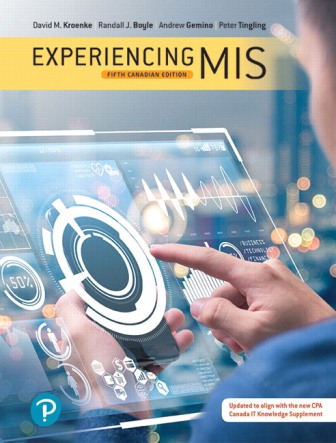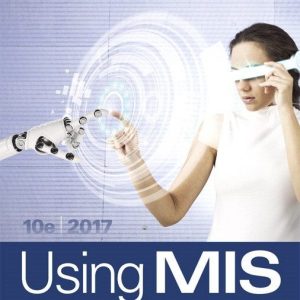Test Bank for Experiencing MIS, 5th Canadian Edition, David M. Kroenke

Product details:
- ISBN-10 : 0132396203
- ISBN-13 : 978-0132396202
- Author: Andrew Gemino
Experiencing MIS is a new generation resource for introductory MIS, created specifically to meet the diverse needs of Canadian business students. It focuses on business process, boasts a bold visual design and is written in a fun and dynamic way to excite students about MIS. Comes fully integrated with robust online resources and additional topics in MyMISLab.
A fresh approach for instructors looking for new and interesting ways to engage students in the fast-paced discipline of MIS.
Table contents:
- Part 1: Why MIS?
- 1. The Importance of MIS
- Q1-1. What Is an Information System?
- Q1-2. What Is MIS?
- Development and Use of Information Systems
- Achieving Business Goals and Objectives
- MIS in Use: Social Media: Changing the Relationship Between Customers and Business
- Q1-3. How Does an IS Differ from IT?
- Q1-4. How Important Are Information Systems to Our Economy?
- Q1-5. How Do Successful Business Professionals Use Information Systems?
- Q1-6. What Is the Shape of Things to Come?
- MIS in Use: Google Knows Best
- Q1-7. What Is This Course About?
- How Does the Knowledge in This Chapter Help You?
- Active Review
- Key Terms and Concepts
- Using Your Knowledge
- Collaborative Exercises
- Case Study 1: Running at the Speed of the Web: The Running Room
- What Do You Think? Duller Than Dirt?
- 2. Business Processes and Decision Making
- Q2-1. “How Did This Stuff Get Here?
- Q2-2. What Is a Business Process?
- Q2-3. What Are the Components of a Business Process?
- Q2-4. What Is Information?
- Definitions Vary
- Where Is Information?
- Characteristics of Good Information
- Q2-5. What Is the Role of Information in Business Processes?
- Business Process Management
- Q2-6. How Do Information Systems Support Business Processes?
- What Does It Mean to Automate a Process Activity?
- An Information System to Support Counter Sales
- An Information System to Support Payment
- An Information System to Support Purchasing
- Q2-7. How Do Information Systems Support Decision Making?
- Decisions Vary by Level
- Decisions Vary by Structure
- Supporting Decision Making
- Q2-8. What Is Your Role?
- MIS in Use: Helm: Software Making Waves
- How Does the Knowledge in This Chapter Help You?
- Active Review
- Key Terms and Concepts
- Using Your Knowledge
- Collaborative Exercises
- Case Study 2: High Touch, High Tech
- What Do You Think? Your Personal Competitive Advantage
- Knowledge Extension 2: Business Process Modelling
- KE2-1. How Can Business Process Modelling Help Organizations?
- How Best Bikes Works
- The Existing Best Bikes Process
- How Best Bikes Processes Must Change To Support 3D Printing
- KE2-2. How Can Information Systems Improve Process Quality?
- What Is Process Quality?
- Using Information Systems to Improve Process Quality
- Use an Information System to Store Vendor Data
- Store Vendor Product and Performance Data in a Database
- Active Review
- Key Terms and Concepts
- 3. Productivity, Innovation, and Strategy
- Q3-1. Why Should I Care About Productivity and Innovation?
- Q3-2. What Is Business Technology Management (BTM), and How Is It Related to Productivity and Innova
- Q3-3. How Do Information Systems Improve Productivity?
- Business Processes and Value Chains
- Q3-4. How Are Organizational Strategy and Industry Structure Related?
- MIS in Use: Winterbourne Bicycle Institute: Building the Biking Experience
- Q3-5. What Is the Relationship Between Innovation and Information Technology?
- Q3-6. How Do Information Systems Provide Competitive Advantage?
- Competitive Advantage via Products and Services
- Competitive Advantage via Business Processes
- Q3-7. Can Competitive Advantage Through Information Systems Be Sustained?
- So What? Your Personal Competitive Advantage
- How Does the Knowledge in This Chapter Help You?
- Active Review
- Key Terms and Concepts
- Using Your Knowledge
- Collaborative Exercises
- Case Study 3: The Amazon of Innovation
- What Do You Think? The Digital Divide
- Knowledge Extension 4: Introduction to Microsoft Excel 2016
- KE4-1. What Is a Spreadsheet?
- KE4-2. How Do You Get Started with Excel?
- KE4-3. How Can You Enter Data?
- Key in the Data
- Let Excel Add the Data Using a Pattern
- KE4-4. How Can You Insert and Delete Rows and Columns and Change Their Size?
- KE4-5. How Can You Format Data?
- KE4-6. How Can You Create a (Simple) Formula?
- KE4-7. How Do I use Vlookup?
- KE4-8. How Do I use Advanced Functions Such as Solver?
- KE4-9. What Are Pivot Tables and How Do I use Them?
- KE4-10. How Can You Print Results?
- Active Review
- Key Terms and Concepts
- Using Your Knowledge
- Part 2: Using Information Technology
- 4. Hardware and Software
- Q4-1. What Do Business Professionals Need to Know About Computer Hardware?
- Hardware Components
- Types of Hardware
- Computer Data
- Computer Data Sizes
- Specifying Hardware with Computer Data Sizes and Processing Speeds
- Q4-2. How Can New Hardware Affect Competitive Strategies?
- The Internet of Things
- Impact of the Internet of Things
- Self-driving Cars
- Self-driving Cars Will Make Things Easier
- Self-driving Cars Will Make Things Cheaper
- Self-driving Cars Will Make Things Safer
- Self-driving Cars Will Disrupt Businesses
- 3D Printing
- Q4-3. What Do Business Professionals Need to Know About Software?
- What Are the Major Operating Systems?
- Nonmobile Client Operating Systems
- Mobile Client Operating Systems
- Server Operating Systems
- Virtualization
- Owning Versus Licensing
- What Types of Applications Exist, and How Do Organizations Obtain Them?
- Horizontal Applications
- Vertical Applications
- One-of-a-Kind Applications
- Selecting an Application Type
- What Is Firmware?
- Q4-4. Is Open Source Software a Viable Alternative?
- Why Do Programmers Volunteer Their Services?
- How Does Open Source Work?
- So, Is Open Source Viable?
- How Does the Knowledge in This Chapter Help You?
- Active Review
- Key Terms and Concepts
- Using Your Knowledge
- Collaboration Exercises
- Case Study 4: Network Effects, Increasing Returns, and Lock-In
- What Do You Think? Keeping Up to Speed
- 5. Database and Content Management
- Q5-1. Why Do You Need to Know About Databases and What Is Their Purpose?
- Reasons for Learning Database Technology
- What Is the Purpose of a Database?
- Q5-2. What Is Content and How Is It Organized?
- Opentext: From Spinoff to Market Leader
- Q5-3. What Does a Database Contain?
- Relationships Among Records
- Metadata
- Q5-4. What Is a DBMS, and What Does It Do?
- The Database Management System
- Creating the Database and Its Structures
- Processing the Database
- Administering the Database
- Q5-5. What Is a Database Application?
- MIS in Use: The Many Names of One Customer
- Forms, Reports, and Queries
- Database Application Programs
- Multiuser Processing
- Q5-6. What Is the Difference Between Databases and Where Are We Headed?
- Need to Store New Data Types Differently
- Need for Faster Processing Using Many Servers
- Nontraditional DBMS Types
- Will These New Products Replace the Relational Model?
- What Do Nonrelational DBMS Mean for You?
- How Does the Knowledge in This Chapter Help You?
- Active Review
- Key Terms and Concepts
- Using Your Knowledge
- Case Study 5: Searching for Pianos …
- What Do You Think? Nobody Said I Shouldn’t
- Knowledge Extension 6: Database Design
- KE6-1. Who Will Volunteer?
- KE6-2. How Are Database Application Systems Developed?
- KE6-3. What Are the Components of the Entity-Relationship Data Model?
- Entities
- Relationships
- KE6-4. How Is a Data Model Transformed into a Database Design?
- Normalization
- Representing Relationships
- KE6-5. What Is the Users’ Role?
- KE6-6. Who Will Volunteer? (Continued)
- Active Review
- Key Terms and Concepts
- Using Your Knowledge
- Knowledge Extension 7: Using Microsoft Access 2016
- KE7-1. How Do You Create Tables?
- Starting Access
- Creating Tables
- KE7-2. How Do You Create Relationships?
- KE7-3. How Do You Create a Data Entry Form?
- KE7-4. How Do You Create Queries Using the Query Design Tool?
- KE7-5. How Do You Create a Report?
- Active Review
- Using Your Knowledge
- 6. The Cloud
- Q6-1. Why Should I Care About Networks?
- Networks and Collaboration
- Network Externalities
- What Is the Global Positioning System (GPS)?
- Q6-2. What Is a Computer Network?
- Q6-3. Why is the Cloud the Future for Most Organizations?
- What Is the Cloud?
- Why Is the Cloud Preferred to In-House Hosting?
- Why Now?
- When Does the Cloud Not Make Sense?
- Q6-4. How Do Organizations Use the Cloud?
- Cloud Services from Cloud Vendors
- Content Delivery Networks
- Use Web Services Internally
- Q6-5. How Can Organizations Use Cloud Services Securely?
- Virtual Private Network (VPN)
- Using a Private Cloud
- Using a Virtual Private Cloud
- So What? Net Neutrality Enabled
- Q6-6. What Does the Cloud Mean for Your Future?
- Q6-7. How Is Mobile Computing Changing the Way We Work and Live?
- A Word of Caution
- MIS in Use: Never Miss Your Bus
- How Does the Knowledge in This Chapter Help You?
- Active Review
- Key Terms and Concepts
- Using Your Knowledge
- Collaborative Exercises
- What Do You Think? Human Networks Matter More
- Knowledge Extension 9: Network and Cloud Technology
- KE9-1. What Is a Computer Network?
- KE9-2. What Are the Components of a LAN?
- Connecting your LAN to the Internet
- KE9-3. How Does the Internet Work?
- An Internet Example
- Carriers and Net Neutrality
- Internet Addressing
- Processing on a Web Server
- KE9-4. How Does the Cloud Work?
- Service-Oriented Architecture (SOA)
- Protocols Supporting Web Services
- Active Review
- Key Terms and Concepts
- Using Your Knowledge
- Part 3: Using IS for Competitive Advantage
- 7. Organizations and Information Systems
- Q7-1. What Are the Fundamental Ways of Achieving Competitive Advantage?
- Q7-2. What Are Business Functions and Functional Systems?
- Functional Silos and Cross-Functional Systems
- Why Are Functional Systems Changing?
- Q7-3. How Can Business Processes Be Improved?
- Integrating Functional Systems: EAI and ERP
- Q7-4. What Are the Challenges of Implementing Business Process Changes?
- Q7-5. What Is the Importance of Industry Standard Processes?
- Q7-6. What Are ERP Systems?
- ERP Characteristics
- Benefits of ERP
- Q7-7. What Are CRM Systems?
- Q7-8. What Are SCM Systems?
- Supplier Relationship Management
- MIS in Use: Yes We Can: Lessons Learned in ERP Implementation at DPT
- How Does the Knowledge in This Chapter Help You?
- Active Review
- Key Terms and Concepts
- Using Your Knowledge
- Collaborative Exercises
- Case Study 7: Moving Like a Deere: Deere’s Innovative Revolution
- What Do You Think? Available Only in Vanilla?
- 8. Decision Making and Business Intelligence
- Q8-1. Do Managers Make Rational Decisions?
- Information Overload
- Data Quality
- Q8-2. What Are OLTP and OLAP and How Do They Support Decision Making?
- Q8-3. What Are Business Intelligence Systems?
- MIS in Use: Sports Decisions Go High Tech
- Q8-4. How Do Organizations Use Data Warehouses to Acquire Data?
- Q8-5. What Are the Differences Between Data Warehouses and Data Marts?
- Q8-6. What Are Typical Data Mining Applications?
- Unsupervised Data Mining
- Supervised Data Mining
- The Market-Basket Example
- Big Data
- How Does the Knowledge in This Chapter Help You?
- Active Review
- Key Terms and Concepts
- Using Your Knowledge
- Collaborative Exercises
- Case Study 8: Building Data for Decision Making at Home Depot
- What Do You Think? Unseen Cyberazzi
- 9. Social Networking, Ecommerce, and the Web
- Q9-1. What Is a Social Media Information System (SMIS)?
- Three SMIS Roles
- SMIS Components
- Q9-2. How Do SMIS Advance Organizational Strategy?
- Social Media and the Sales and Marketing Activity
- Social Media and Customer Service
- Social Media and Inbound and Outbound Logistics
- Social Media and Manufacturing and Operations
- Social Media and Human Resources
- So What? Facebook for Organizations
- Q9-3. How Do SMIS Increase Social Capital?
- What Is the Value of Social Capital?
- How Do Social Networks Add Value to Businesses?
- Q9-4. How Do (Some) Companies Earn Revenue From Social Media?
- You Are the Product
- Revenue Models for Social Media
- Does Mobility Reduce Online Ad Revenue?
- Q9-5. How Can Organizations Address SMIS Security Concerns?
- Managing the Risk of Employee Communication
- Managing the Risk of Inappropriate Content
- Internal Risks from Social Media
- Q9-6. Where Is Social Media Taking Us?
- Q9-7. What Is Ecommerce, and How Is It Used?
- Ecommerce Merchant Companies
- Nonmerchant Ecommerce
- Benefits of Ecommerce
- The Challenges of Ecommerce
- So What? Synthetic Friends
- MIS in Use: Digital Is Forever
- How Does the Knowledge in This Chapter Help You?
- Active Review
- Key Terms and Concepts
- Using Your Knowledge
- Collaboration Exercises
- Case Study 9: Let Me Get That: Buyatab and Where Good Ideas Come From
- What Do You Think? Hiding the Truth?
- Part 4: Information Systems Management
- 10. Acquiring Information Systems Through Projects
- Q10-1. How Can Information Systems Be Acquired?
- Q10-2. What Are IT Projects, and What Does PMBOK Mean?
- Q10-3. What Should You Know About IT Operations and IT Projects?
- What About the Web?
- Q10-4. Why Are IT Projects So Risky?
- Q10-5. What Is a SDLC?
- Phase 1: Defining Systems
- Phase 2: Requirements Analysis
- Q10-6. How Are Information Systems Designed, Implemented, and Maintained?
- Phase 3: Component Design
- Phase 4: Implementation
- Phase 5: Maintenance
- Q10-7. What Is Outsourcing, and What Are Application Service Providers?
- Application Service Providers
- MIS in Use: From Lemons to Lemonade
- How Does the Knowledge in This Chapter Help You?
- Active Review
- Key Terms and Concepts
- Using Your Knowledge
- Collaborative Exercises
- Case Study 10: Email or Freemail?
- What Do You Think? The Real Estimation Process
- Knowledge Extension 16: Introduction to Microsoft Project
- KE16-1. What Is Project Management Software?
- KE16-2. How Do I Create and Manage Tasks?
- Creating Subtasks
- Creating Dependencies
- KE16-3. How Do I Manage Resources?
- Adding Resources to Tasks
- Active Review
- Key Terms and Concepts
- Using Your Knowledge
- 11. Structure, Governance, and Ethics
- Q11-1. How Is the IT Department Organized?
- What About the Web?
- Q11-2. What Jobs Exist in IT Services?
- So What? Jumping Aboard the Bulldozer
- Q11-3. What Is IT Architecture?
- Q11-4. What Is Alignment, Why Is It Important, and Why Is It Difficult?
- Q11-5. What Is Information Systems Governance?
- The Sarbanes-Oxley Act (SOX) and the Budget Measures Act (Bill 198)
- Summary
- Q11-6. What Is an Information Systems Audit, and Why Should You Care About It?
- Why Should You Care About Information Systems Governance and Information Systems Audits?
- Q11-7. What Is Information Systems Ethics?
- MIS in Use: Sarbanes-Oxley: Boon or Bane?
- Q11-8. What Is Green IT, and Why Should You Care About It?
- How Does the knowledge in This chapter help you?
- Active Review
- Key Terms and Concepts
- Using Your Knowledge
- Collaborative Exercises
- Case Study 11: Governance at Pacific Blue Cross
- What Do You Think? The Ethics of Misdirected Information
- 12. Managing Information Security and Privacy
- Q12-1. What Is Identity Theft?
- Q12-2. What Is PIPEDA?
- So What? Protecting Yourself from Identity Theft
- Q12-3. What Types of Security Threats Do Organizations Face?
- Unauthorized Data Disclosure
- Incorrect Data Modification
- Faulty Service
- Denial of Service
- Loss of Infrastructure
- Elements of a Security Program
- Q12-4. How Can Technical Safeguards Protect Against Security Threats?
- Identification and Authentication
- Single Sign-On for Multiple Systems
- Encryption and Firewalls
- Malware Protection
- Malware Safeguards
- Q12-5. How Can Data Safeguards Protect Against Security Threats?
- Q12-6. How Can Human Safeguards Protect Against Security Threats?
- Human Safeguards for Employees
- MIS in Use: What Is My True Name?
- Human Safeguards for Non-employees
- Account Administration
- How Can You Create a Strong Password?
- Security Monitoring
- MIS in Use: Privacy and the Federal Government
- Q12-7. What Is Disaster Preparedness?
- Q12-8. How Should Organizations Respond to Security Incidents?
- How Does the Knowledge in This Chapter Help You?
- Active Review
- Key Terms and Concepts
- Using Your Knowledge
- Collaborative Exercises
- Case Study 12: Phishing for Credit Card Accounts
- What Do You Think? The Final, Final Word
- Glossary
- Index
- Back Cover
People also search:
experiencing mis 8th edition
experiencing mis
can miscarriage happen in 5th week
bmw 5 series price in canada
minor 5th vs diminished 5th





